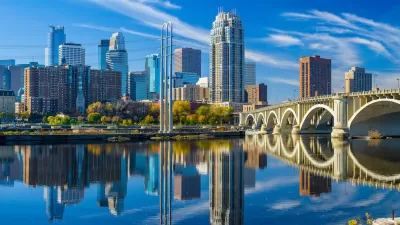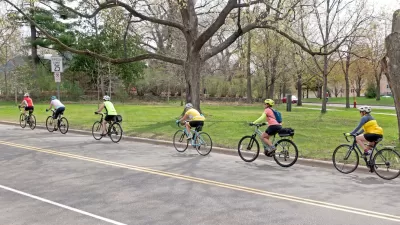Already a source of eternal controversy for their effects on street life and local business, pedestrian skyways have proven even more problematic during the pandemic.

Jake Blumgart reports on the latest developments in the planning of pedestrian skyways—the effects of the pandemic adding new questions about the effects of skyways local retail and public safety.
Blumgart helpfully notes the history of skyway planning and development in the Twin Cities, where this story focuses its attention:
Minneapolis inaugurated the skyway era in 1962 and eventually built out a system with 9.5 contiguous miles of second-story connections between office buildings, hotels and housing towers. St. Paul soon followed, and has five miles of its own. The idea was to compete with suburban office parks and shopping malls, giving aged downtowns an edge — especially in the winter months.
The results, however, have underwhelmed:
From the beginning, skyways were controversial. Critics feared they would imperil existing sidewalk-facing businesses. Today, the streetscape of the two cities is remarkably quiet. With consumer dollars focused on the second floor, street-level stores and restaurants suffer. (It’s worth noting that downtowns as varied as Baltimore and Los Angeles manage a similar deadening effect without skyways.)
The pandemic has accelerated some of the less desirable effects of the skyway approach to downtown circulation. With office emptied out, like they are in so many other cities, the skyways in the Twin Cities have become dark and filled with litter, cigarette smoke, and encampments, according to Blumgart.
The future of the skyways depends on how many people return to the office if and when the public health situation improves, according to the article. While the trends indicate a return to the office, the daytime office population of the Twin Cities is still far below the pre-pandemic precedent.
FULL STORY: The Twin Cities Skyways Face an Uncertain Future

Alabama: Trump Terminates Settlements for Black Communities Harmed By Raw Sewage
Trump deemed the landmark civil rights agreement “illegal DEI and environmental justice policy.”

Planetizen Federal Action Tracker
A weekly monitor of how Trump’s orders and actions are impacting planners and planning in America.

The 120 Year Old Tiny Home Villages That Sheltered San Francisco’s Earthquake Refugees
More than a century ago, San Francisco mobilized to house thousands of residents displaced by the 1906 earthquake. Could their strategy offer a model for the present?

Opinion: California’s SB 79 Would Improve Housing Affordability and Transit Access
A proposed bill would legalize transit-oriented development statewide.

Record Temperatures Prompt Push for Environmental Justice Bills
Nevada legislators are proposing laws that would mandate heat mitigation measures to protect residents from the impacts of extreme heat.

Downtown Pittsburgh Set to Gain 1,300 New Housing Units
Pittsburgh’s office buildings, many of which date back to the early 20th century, are prime candidates for conversion to housing.
Urban Design for Planners 1: Software Tools
This six-course series explores essential urban design concepts using open source software and equips planners with the tools they need to participate fully in the urban design process.
Planning for Universal Design
Learn the tools for implementing Universal Design in planning regulations.
Clanton & Associates, Inc.
Jessamine County Fiscal Court
Institute for Housing and Urban Development Studies (IHS)
City of Grandview
Harvard GSD Executive Education
Toledo-Lucas County Plan Commissions
Salt Lake City
NYU Wagner Graduate School of Public Service




























